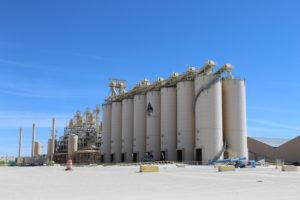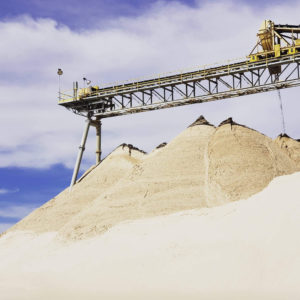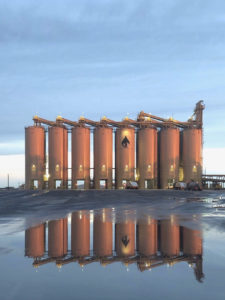 Amid the shifting landscape of the oil patch over the last two-plus years, completions have been among the sectors most buffeted by the changes. And frac sand is right in the middle of the storm.
Amid the shifting landscape of the oil patch over the last two-plus years, completions have been among the sectors most buffeted by the changes. And frac sand is right in the middle of the storm.
Frac sand suppliers have re-engineered, refocused, and reduced, only to quickly begin ramping back up as demand shot up in the first quarter of 2021, hiring back as many as they could among those who had been laid off. Thing has improved enough now that one of the major players is planning an IPO—the first in the service industry in four years.
By integrating a method of logistics planning, Ft. Worth-based Black Mountain Sand has done better than many frac sand suppliers, said company CEO Jason Morin. “It’s been an extreme ride, for sure. We had to make some serious changes, really, at a time of maximum uncertainty,” he said. “We had to right-size our business to match the needs of our customers, which is very difficult to do when they don’t have great visibility of their own businesses” due to marketplace uncertainty.
By consolidating around their most efficient functions with an eye toward being able to ramp back up when the time was right, they rode out the storm. Fortunately, the extremely bad times didn’t last long. Black Mountain began stepping back up on production in late summer of 2020, increasing volumes gradually in sync with demand growth. Morin said that while they had to reduce staff during the downturn, they eventually hired back most of their previous employees, at least those who had not found other jobs.
The company also used their downtime to invest in new technologies, focusing on areas such as lab data management, safety, control room operations, chemicals management, and advanced maintenance tools. “These investments are really designed to improve our efficiency and productivity. That allows our employees to focus more on value-added tasks,” he said. Value-added tasks include areas that require planning and judgment that only humans can provide.
Acknowledging that the industry as a whole is experiencing supply chain issues with last-mile delivery and other needs, Morin said the biggest change from pre-COVID times is that “the customer preference pendulum is swinging back towards bundling, from direct sourcing.” Most of the growth in sand needs came from smaller operators, who are less interested in “handling the details of sourcing sand themselves. So in dealing with the trucking shortages and sand challenges, that does lend itself more toward bundling the logistics,” Morin explained.
He noted that last-mile logistics of sand are usually handled by the pressure pumper or a third-party logistics provider, such as the owner of the sand containers. “We would normally organize the trucking or coordinate with the third party. Then once it’s picked up from our facility, they would manage it onsite at the well pad.” 
When sand needs first exploded in early first quarter of 2022, Morin said there was some makeup capacity required from suppliers of Northern White sand, but that later in the quarter local demand ramped up to fill most of the demand. He sees customers now compensating by planning jobs out further to assure a sand supply before the frac job starts.
One issue faced by everyone in almost every industry is the supply chain backlog. Reliably sourcing machinery parts is a significant concern. Morin said frac sand is abrasive to the equipment, making frequent parts replacements necessary. Keeping a supply of those parts requires extra effort on the part of those involved. “Our team has done a great job under the circumstances, but it is a battle every single day,” he said.
Sand mines in Wisconsin are among the main sources of the Northern White that arrives in the Permian Basin. Erick Beaudoin, a director for Gordon Brothers’ Industrial Inventory Appraisal Practice, in Mequan, Wisc., says Wisconsin sand also travels to oil fields in the Bakken, Appalachia, and the Marcellus, as well as to the Permian Basin.
It was around 2010-11, as the frac revolution went into high gear, that sand mines started “popping up all over Wisconsin,” Beaudoin said. “The reason being, we have a high concentration of very high quality sand. What makes it high quality is that it has a very high percentage of quartz sand. Quartz is a very hard material that’s got a very high crush rate—it can withstand high pressures, and it’s a very clean and consistent sand that the frac’ing companies love to use.” In the early days, it was the only sand with a high enough crush factor to be considered for frac use.
As the frac revolution continued and larger amounts of sand were applied to each frac job, the expense of transporting those bigger loads across hundreds of miles began to add up. Producers in the Permian then began to look more locally. McCulloch County, where Brady and Mason are the main towns, became a hotbed of frac sand mines a few years later. Completion companies felt any production lost to softer sand would be compensated by the lower costs of fracs. They also began to redesign fracs to accommodate the McCulloch County product.
That helped, but it was still more than 200 miles to many frac sites. Around 2017 completion companies began using brown sand common to the area within a few miles of Midland, Odessa, and Monahans, which is where much of Black Mountain Sand’s mining operations are.
This had the effect of shutting out almost all of the Northern White in the Permian. But in 2021, as COVID shutdowns began to ease and oil production ramped back up, Permian producers could not boost production quickly enough. Producers anxious to boost activity quickly by completing some of their drilled but uncompleted wells (DUCs), quickly outstripped the area mines’ ability to recover—so Northern White rode back into town to the rescue, at least somewhat.
Explaining the money issue, Beaudoin said, “The cost from the mine in Wisconsin might only be $25-$30 a ton, but where the costs really pick up is where you ship that sand.” Getting the sand to West Texas might add $80-$100 per ton, many times its original price.
Early fracs used a coarser mesh of 16/40 to 30/50, which was easy to find up north. As time went along, as frac jobs went more and more to horizontal designs, grades of 40/70 and 100 mesh grew in demand. The finer grade flows better through the laterals and embeds itself into smaller fissures. Wisconsin wells have less of the finer sand, so many of the smaller and less-well-run mines have shut down, Beaudoin said. Many went under during the COVID crisis.
However, starting in 2021, trucking shortages made it difficult to get in-basin sand to the frac job. Another slowdown came about from labor shortages at some of the mines.
 “The nice thing about the Wisconsin sand, when it goes to West Texas, it’s all on rail. So you don’t have those trucking issues you have with the in-basin sand,” he said. Beaudoin did acknowledge the last-mile issues of getting the Northern White from the rail line to the frac location, that still apply wherever the sand originated.
“The nice thing about the Wisconsin sand, when it goes to West Texas, it’s all on rail. So you don’t have those trucking issues you have with the in-basin sand,” he said. Beaudoin did acknowledge the last-mile issues of getting the Northern White from the rail line to the frac location, that still apply wherever the sand originated.
One challenge for Texas frac’ers turning to Wisconsin is that the northern sand mines have long-term contracts with buyers elsewhere, and have only a certain amount of spare capacity to send south—even though the increased demand has boosted spot prices for their sand. Wisconsin sand is also going toward glass production and other non-oil applications. “They [Wisconsin sand companies] have relationships with their top customers, and they don’t want to start diverting supply to other people just because get a little better price.”
Beaudoin feels there little extra capacity available for Texas, beyond those existing contracts.
Black Mountain’s Morin feels that most of the Permian mines are now back in sufficient production to limit the need for Northern White except in mines that still require the higher crush and larger mesh sands.
Signs of Life
As of late April, Reuters was reporting on an anonymous tip that frac giant Atlas sand was investigating the possibility of an initial public offering (IPO), which would be the first for an oilfield service company since 2018. At this writing there were no comments from either Atlas Sand or Goldman Sachs, who was reportedly hired to lead preparations. The report said Atlas Sand could be valued at $2 billion to $3 billion including debt.
Many in the industry are seeing this as a good sign for a frac sand sector that has been battered, like the rest of the industry, by whipsaw changes in prices and demand.
_____________________________________________________________________________________________________
By Paul Wiseman









